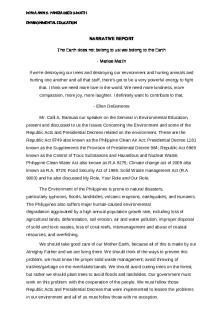Local History Narrative Sarung Banggi PDF

| Title | Local History Narrative Sarung Banggi |
|---|---|
| Author | Mark Betito |
| Course | Accountancy |
| Institution | Bicol University |
| Pages | 4 |
| File Size | 630.9 KB |
| File Type | |
| Total Downloads | 545 |
| Total Views | 799 |
Summary
BICOL UNIVERSITYCOLLEGE OF BUSINESS, ECONOMICS, & MANAGEMENTDEPARTMENT OF ACCOUNTANCYA. 2021-MARK JOHN BETITO PROF. RUBY ANN L. AYO, PhD BSA-1D ProfessorTThe Melody of the Past: A Local History Narrative of Sarung BanggiEven before the colonization of the Spaniards in the Philippines, Filipinos ...
Description
BICOL UNIVERSITY COLLEGE OF BUSINESS, ECONOMICS, & MANAGEMENT DEPARTMENT OF ACCOUNTANCY A.Y. 2021-2022
MARK
P
YO, PhD
The Melody of the Past: A Local History Narrative of Sarung Banggi Even before the colonization of the Spaniards in the Philippines, Filipinos already had gilded musical traditions. This music was usually played during convivial gatherings, official celebrations, rites and rituals, weddings, and entertainment, especially in the presence of venerated guests. However, with the influences of the Spaniards on our culture, these musical traditions continue to evolve, leading to the birth of a new era of melodious renditions that embodies universality, consciousness, love, and patriotism - truly capturing the collective historical and cultural background of a particular people. This type of music is commonly known as kundiman - a genre of folk songs that emerged in the late 1800s towards the end of the Philippines' Spanish colonial Period. A kundiman is a Filipino love song traditionally sung by a man for the woman of his dreams, however, there is more to this song that is hidden by its lyrics. As proof of the unsurpassed rich influence of kundiman is Sarung Banggi, a century-old song from Sto. Domingo, Albay. To deepen the understanding of the song's historical development, historicists is used in this narrative as a perspective to ascribe the events and factors that conduce to the song's composition like time, historical period, geographical place, and notable personalities and of course, the song itself. Collectively, these elements serve as the foundation to contextualize the narratives and interpret these historical materials. Over and above these elements, historical criticism is also used to understand the events and experiences surrounding the song. Specifically, cross-referencing of different materials researched by notable local historians was done to understand the reality behind the song and boost the credibility of the write-up. Sarung Banggi, 'One Night' in English, is still one of the most popular kundiman songs that transcend through time. In its heyday, according to an interview with the locals of Salvacion, Sto. Domingo, Albay, the whole province would play this song for enjoyment, during fiestas, (especially misis-misis) and other special occasions. This 103-year-old Bicolano song was originally composed by Potenciano "Poten" Balladolid Gregorio Sr., a native of Lib-og, now called Sto. Domingo in Albay (route used by the Spaniards on the way to the town of Tabaco.) Potenciano Gregorio was the younger of two children of Narcisso Gregorio and Canuta Balladolid. He was born in 1880 and baptized on May 22, the same year. At the young age of three, he was already considered a music prodigy who could play the violin and other musical instruments. His first teacher who cultivated his talents was Fr. Forge I. Barlin, the curate of Lib-og town from the year 1883 to 1885. As he grew older, he started composing religious music for the church and often collaborated with his brother Bernardo. According to the research and interviews made by Bicol Historian Dr. Merito Espinas to the composer's descendants, the song was first written in 1897 when Gregorio was just a 17-year-old lad. However, the piece was only completed on May 10, 1910. Banda de Lib-og first played the composition, a band lead by Potenciano Gregorio in August 1910 during the town fiesta in Guinobatan, Albay, not in his hometown of Lib-og. With all of these interesting facts about the composer, one question has long fascinated many great minds: what is the meaning behind the song? Musically, the song is viewed as a story of Potenciano Gregorio spurred to poetics for the adoration of his girl. Th
The song gave a feeling of constant longing while waiting to be with his beloved. As supported by the narratives of Ressureccion Gregoria, great-grandson of the composer, Lolo Poten wrote the song because he wanted to dedicate it to a local Bicolana girl named Dominga Duran, who later became his wife. This aspect of the song shows the bygone era where love was pure and respect was prevalent in the relationship. This further illustrates the courtship practices during that time singing romantic songs and writing poems are among them. Furthermore, in 1962, the nephew of Potenciano Gregorio, Justo Gregorio, recalled that when his uncle Potin was only 17 years old, he woke up one evening after hearing the noise coming from the chirping of the birds, the rustling of the leaves outside their house together with the rumbling of the Mayon Volcano is what inspires him to write the song. The line from the song "…nakadangog ako, huni nin sarung gamgam, bako kundi simong boses iyo palan…" could be a double-edge metaphor to indicate the sounds of the birds, the Mayon Volcano as the characteristics of the voice of his wife. On the surface, the song is all about love, the sweet chirping of the bird, and the deleterious rumbling of the volcano, whichever way you want to interpret it. However, given the song's time and place of origin, a deeper meaning lies between the lyrics. Sarung Banggi also has an underlying intent of expressing enlightenment - a protest song disguised as love song. Politically, it can be noted that the composer was born during the end of the Philippines' Spanish colonial period and grew up to the emerging American imperialism. This could have contributed to the very strong message of enlightenment that can be found in the song. According to another notable Bicol Historian, Jose Barrameda, the song never mentioned about love but strongly suggested by the overall effect and impression of the song. He explained that the singer is awakened one night by the singing of the bird; he imagines it to have been a product of a dream; then he realizes that the birdsong is actually that of his beloved. Using cross referencing, it might be pointed out that the bird-Philippine metaphor was actually employed for the same patriotic purposes, though not quite poetically, in Jose Corazon de Jesus' Ang Bayan Ko. This shows that Sarung Banggi is not just all about love and serenity; it also shows a side of awakening and longing for independence. Beyond the lyrics, one can say that it hides a deeper message of love. This powerful song is worthy of being preserved and be acclaimed not only locally but also internationally. Aside from the soothing tune of Sarung Banggi that brings nostalgic feeling, it is also a great reminder of how beautiful our culture is - from the way of courtship, connection to nature, creativity, the happy disposition of Albayanos, and to the fiery sense of nationalism. It truly invoked a feeling of pride to the heritage of the Bicolano spirit - giving us a glimpse of the lives of our proud ancestors. Potenciano Gregorio’s musical prowess challenge the time and brings a relevant message to this contemporary world. He was able to turn his innermost emotions into an instrument that reflects hopes, longing, and love - things that we needed most in the present.
SOURCES: 2021. The Most Famous Kundiman. Retrieved, December 13, 2021, from https://www.allaroundthisworld.com/filipino-kundiman/#.YbcBCb1BzIX. Sto. Domingo Albay. Retrieved December 4, 2021, from http://rsso05.psa.gov.ph/Albay-Tourism/Sto.%20Domingo/sto_domingo.html 2015. Sarong Banggi and the Dearth of Mainstream Bikol Songs. Retrieved December 4, 2021,cbanga360.net/2015/04/11/sarong-banggi-and-the-dearth-of-mainstream-bico l-songs/ Espinas, M. Sarung Banggi, Bikol’s Regional Song. Retrieved, December 4, 2021, from https://www.ustdigitallibrary.contentdm.oclc.org Barrameda, J.Sarung Banggi: A Beautiful Subversive Song. Retrived December 4, 2021, fromhttps://ph.news.yahoo.com/blogs/the-inbox/festival-celebrate-133rd-birthdaysarung-banggi-composer-143057481.html?guccounter=1&guce_referrer=aHR0cHM6 Ly93d3cuZ29vZ2xlLmNvbS8&guce_referrer_sig=AQAAAKrBv8OnOFwh3vWYgnVloNu rylTvi93NBlsUiTMIZHRLREgUDswjqSYVNyFB1DzggxGXirjWxmGgVjK_zCo_T1j9WCcTQ mEPb4eugP6EnJivi1n0-rUNzxm-SWL7QVwb_JRSlZs3r-vOLjvJ9ZDsYsk10_RQenIPiNS7o emqH0Ns 2011. Sarung Banggi. Retrieved December 4, 2021, from SARUNG%20BANGGI/TUNOG%20BIKOL_%20SARUNG%20BANGGUI.html Bayan Ko. Retrieved December 4, 2021, from https://philippineculturaleducation.com.ph/bayan-ko/ Tariman, P. 2013. Sarung Banggi: From Music to Film. Retrieved December 4, 2021, from https://muntingnayon.com/102/102619/...
Similar Free PDFs

LOCAL LITERATURE
- 5 Pages

Administración Local
- 2 Pages

Local Governance
- 6 Pages

Anestesia local
- 18 Pages

NARRATIVE REPORT
- 1 Pages

NARRATIVE REPORT
- 7 Pages

Literacy Narrative
- 5 Pages

Narrative Tenses
- 8 Pages

Narrative - adadsa
- 19 Pages

Regimen local - Apuntes 1
- 16 Pages

EL Sistema Tributario local
- 23 Pages
Popular Institutions
- Tinajero National High School - Annex
- Politeknik Caltex Riau
- Yokohama City University
- SGT University
- University of Al-Qadisiyah
- Divine Word College of Vigan
- Techniek College Rotterdam
- Universidade de Santiago
- Universiti Teknologi MARA Cawangan Johor Kampus Pasir Gudang
- Poltekkes Kemenkes Yogyakarta
- Baguio City National High School
- Colegio san marcos
- preparatoria uno
- Centro de Bachillerato Tecnológico Industrial y de Servicios No. 107
- Dalian Maritime University
- Quang Trung Secondary School
- Colegio Tecnológico en Informática
- Corporación Regional de Educación Superior
- Grupo CEDVA
- Dar Al Uloom University
- Centro de Estudios Preuniversitarios de la Universidad Nacional de Ingeniería
- 上智大学
- Aakash International School, Nuna Majara
- San Felipe Neri Catholic School
- Kang Chiao International School - New Taipei City
- Misamis Occidental National High School
- Institución Educativa Escuela Normal Juan Ladrilleros
- Kolehiyo ng Pantukan
- Batanes State College
- Instituto Continental
- Sekolah Menengah Kejuruan Kesehatan Kaltara (Tarakan)
- Colegio de La Inmaculada Concepcion - Cebu




